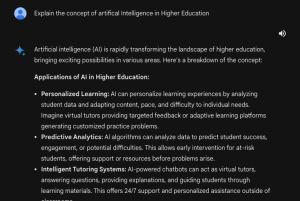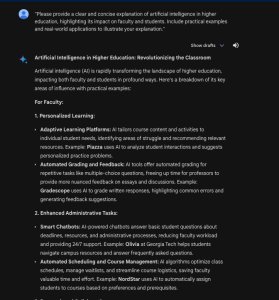Introducing Prompts
In this section, we will look at the important skill of prompt engineering. Prompts are the instructions you provide the GenAI, which play the most significant role in shaping the responses you receive. Crafting effective prompts necessitates thoughtful consideration to elicit optimal outputs. While the process may seem idiosyncratic, there are strategies you can employ to achieve desired results. For educators, understanding the art of prompt crafting not only enhances interactions with AI tools but also offers deeper insights into artificial intelligence by highlighting patterns of consistency and variance in content generation.
What are prompts?
They are input elements such as words, phrases, questions, or keywords that users enter into GenAI tools to generate results. Now that you know what prompts mean, prompt generation is the skillful art of crafting highly effective prompts to achieve the desired outcomes.
In the context of ChatGPT, prompts refer to the instruction or discussion topic that users provide for the GenAI model to respond to. It can take the form of a question, statement, or any stimulus aimed at fostering creativity, reflection, or engagement. These prompts are designed to be open ended allowing customisation to align with the user’s preferences and interests.
What makes a good prompt?
Firstly, when using GenAI tools like ChatGPT, Copilot or Gemini, the better your prompts, the better the results you will get. Simply put, an effective prompt not only sets the topic but also provides clear instructions on the task, effectively guiding the tool.
Is it challenging to write a good prompt? Creating effective prompts can be a challenging task, as the quality of the output relies on the specificity and clarity of the prompts or input instructions. This is why we’ve created this whole resource site, so that you can see some effective prompts for learning.
Principles for good prompting
- Craft precise and unambiguous instructions.
- Use the conversational interface on many generative AI tools to refine its outputs.
- Specificity is key! The model will make an assumption on any point you don’t clearly explain.
- Formulate a relevant prompt.
- Consider when the completions fall short of expectations.
- Enhance the clarity of the prompt. You could refine your prompts using a set of exemplars*.
- Repeat the process to iteratively improve your prompt’s effectiveness
Remember that as you chat with the GenAI tool, it will learn more about what you need. Use the conversational turns to help the tool improve its outputs. Also remember that simple prompts lead to simple (and similar) completions.
*How to refine a prompt with an exemplar:
Original Prompt:

Refined Prompt with Exemplar:
![]()

This refined prompt includes specific instructions and exemplars such as “impact on faculty and students” and “practical examples” to guide the response towards a more detailed and informative explanation.
Attribution: Adapted from University Of Sydney AI in Education https://canvas.sydney.edu.au/courses/51655 The content in this Canvas course is licensed under a Creative Commons BY-NC 4.0 licence

